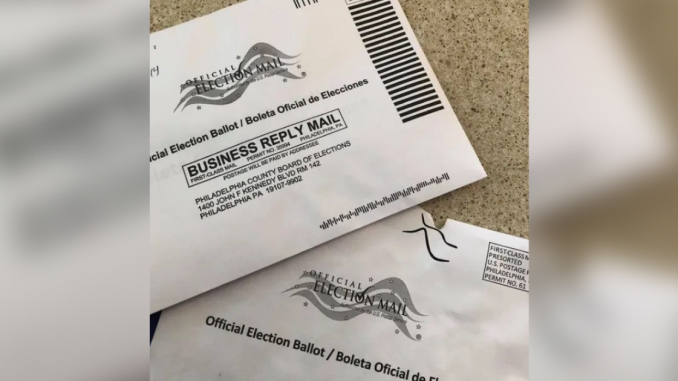
| Published August 26, 2025
In-Person vs. Mail-In Voting: A Nation Divided on Election Security
When Americans cast their ballots, they aren’t just choosing leaders—they’re also making a statement about how much they trust the system itself. A new poll from Rasmussen Reports, highlighted by The Gateway Pundit, shows that 53% of likely voters believe in-person voting is more secure than mail-in ballots. Only 13% believe mail voting offers greater security, while 30% say the difference doesn’t matter much.
The results reflect a widening divide in how Americans view the very mechanics of democracy.
A Tale of Two Systems
For millions, showing up at the polls feels like the gold standard of voting. The process is tangible: present ID, mark a ballot, feed it into a machine, and walk away with a sticker that says, “I Voted.” That physical act provides reassurance against tampering.
But for others, especially those juggling jobs, caregiving, disabilities, or military service overseas, mail-in ballots are not just convenient—they’re essential. Over the past decade, mail voting has expanded dramatically, praised for boosting accessibility and turnout.
According to Pew Research, 58% of Americans support no-excuse mail-in voting, underscoring that public opinion is far from one-sided. Democrats overwhelmingly back the practice, while Republicans remain largely opposed.
Confidence and Skepticism
Behind the polling data lies a deeper story: confidence in elections is increasingly split along partisan lines. Gallup finds that while 84% of Democrats are confident their votes will be counted accurately, only 28% of Republicans feel the same. This gap reflects not just differing views on policy, but a fundamental divide over whether the system itself can be trusted.
The AP-NORC poll adds another layer: most voters trust local and state officials to count ballots fairly, but Republicans are far less confident in nationwide tallies.
The Political Stakes
These perceptions are not just academic—they’re shaping laws. GOP-led legislatures are pushing tighter rules on absentee ballots, citing security. Democratic-led states continue to expand mail access, arguing that it increases participation without jeopardizing integrity.
The result is a patchwork of voting laws across the country, leaving many voters confused and fueling accusations of unfairness.
Beyond U.S. Borders
America’s internal debates don’t go unnoticed abroad. Foreign governments—especially rivals like China and Russia—capitalize on the perception of a divided electorate to question U.S. credibility as a global champion of democracy. If Americans can’t agree on how to vote, critics ask, how can they lead others on the principles of free elections?
The Bigger Picture
Despite fears, experts stress that mail-in voter fraud remains rare. Safeguards such as signature verification, ballot tracking, and strict chain-of-custody rules are in place. Studies repeatedly show that both in-person and mail voting are secure, though each carries unique risks.
Still, perception often outweighs facts. If voters believe a system is insecure, that belief can be just as damaging as actual vulnerabilities.
President Trump vowed to rid the country of mail-in voting, voting machines, and clean up elections.
Trump will sign an executive order to rid the country of mail-in voting and highly “inaccurate” voting machines.
President Trump: I am going to lead a movement to get rid of MAIL-IN BALLOTS, and also, while we’re at it, Highly “Inaccurate,” Very Expensive, and Seriously Controversial VOTING MACHINES, which cost Ten Times more than accurate and sophisticated Watermark Paper, which is faster, and leaves NO DOUBT, at the end of the evening, as to who WON, and who LOST, the Election.
We are now the only Country in the World that uses Mail-In Voting. All others gave it up because of the MASSIVE VOTER FRAUD ENCOUNTERED. WE WILL BEGIN THIS EFFORT, WHICH WILL BE STRONGLY OPPOSED BY THE DEMOCRATS BECAUSE THEY CHEAT AT LEVELS NEVER SEEN BEFORE, by signing an EXECUTIVE ORDER to help bring HONESTY to the 2026 Midterm Elections.
Remember, the States are merely an “agent” for the Federal Government in counting and tabulating the votes. They must do what the Federal Government, as represented by the President of the United States, tells them, FOR THE GOOD OF OUR COUNTRY, to do.
 Individuals in Michigan drop several ballots in an unguarded Detroit drop box in 2020 (via MC4EI and Gateway Pundit)
Individuals in Michigan drop several ballots in an unguarded Detroit drop box in 2020 (via MC4EI and Gateway Pundit)
 Implications of the Findings
Implications of the Findings
1. Polarization of Election Legitimacy
-
The Rasmussen poll (cited in the Gateway Pundit piece) reinforces a deep divide over election methods.
-
Since Republicans are far more skeptical of mail-in ballots, this erodes bipartisan agreement on what counts as a “secure” election.
-
That divide risks contested outcomes—where losing sides may not just dispute results but the methods themselves.
2. Policy Pressure on State Legislatures
-
Expect GOP-led states to feel emboldened to restrict mail voting further (tighter ID requirements, limits on absentee ballots, more push for in-person-only).
-
Democratic-led states will likely defend or expand mail and early voting access, citing convenience and turnout.
-
This leads to a patchwork of rules across states—confusing for voters, especially in federal elections.
3. Impact on Voter Confidence & Turnout
-
When half the country perceives one system as “less secure,” confidence in election outcomes suffers.
-
Lower confidence could discourage some voters from participating—or push them toward only voting in person.
-
Meanwhile, mail voters (especially older voters, military, and overseas voters) could face hurdles if states restrict access.
4. Narrative for 2026 and 2028 Elections
-
This polling will feed into campaign talking points:
-
Republicans: “Mail voting is insecure, we must protect elections.”
-
Democrats: “Voting access is under attack, mail ballots are safe and necessary.”
-
-
Election integrity debates may become as defining as the issues themselves (immigration, economy, foreign policy).
5. Potential Legal Battles
-
If states act on these sentiments, court challenges are inevitable.
-
Legal disputes will center on whether mail-voting limits violate voting rights or discriminate against specific groups (disabled, elderly, overseas voters).
-
Expect a replay of the 2020–2022 wave of lawsuits, but more targeted around security vs. access trade-offs.
6. Global Perception
-
U.S. democracy already faces skepticism abroad.
-
Polls showing that nearly half of Americans don’t trust mail ballots may be used by foreign actors (e.g., China, Russia) to undermine confidence in American elections.
-
It risks soft power credibility, especially as the U.S. criticizes other nations’ electoral systems.
 Overall Takeaway:
Overall Takeaway:
The Rasmussen poll highlighted by The Gateway Pundit shows that most Americans—53%—still see in-person voting as more secure than mail-in ballots. While this perception fuels ongoing debate, the broader research reveals a more complex picture: many voters, especially Democrats, continue to support expanded mail voting, even as Republicans push back.
The real issue isn’t only about voting methods—it’s about trust in the system itself. Partisan divides over election security risk deepening polarization, shaping state-level policies, and setting the stage for renewed legal and political battles in upcoming elections. As both parties sharpen their narratives, the struggle over “how America votes” is becoming just as central as “who America votes for.”
Ultimately, the future of U.S. elections will hinge not only on laws and procedures but also on whether leaders can restore a shared sense of confidence in the democratic process.





Be the first to comment